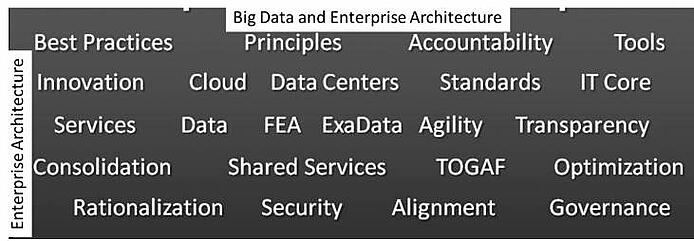Enterprise Data Architecture and Big Data
As I meet customers, it’s dawning on me that IT leadership is not paying attention to fundamentals like Enterprise Data Architecture.
By treating big data as a “one-off” project, rather than an ongoing foundation that provides the context, environment, and capabilities to enable value creation and delivery to the organization…we might be sowing the destructive seeds for another crisis.
To what extent have you embraced big data? Is it still an experiment or has it become the foundation of your IT strategy? As data capabilities mature and the operational realities settle in, enterprise data architectures are undergoing a high stakes transformation.
Managing architecture has always been a big IT challenge. Enterprise Data today is in a state of constant evolution. As a result, business processes and platforms become increasingly more difficult to change and more costly to keep up-to-date. The solution to this predicament is an Enterprise Data Architecture that can provide a framework for a flexible data asset portfolio.
 History has repeatedly taught us that the bigger the IT shift, the more care is needed in planning and architecture. Managing the high stakes impact of big data requires a comprehensive set of architectural principles that ensure consistency, coherence and make applications more responsive, efficient and economical.
History has repeatedly taught us that the bigger the IT shift, the more care is needed in planning and architecture. Managing the high stakes impact of big data requires a comprehensive set of architectural principles that ensure consistency, coherence and make applications more responsive, efficient and economical.
What is your data maturity level?
Do you understand the overall picture? Data is an unlikely raw material but it’s a valuable asset. Data rationalization, standardization, and consolidation process forces organizations to understand their current data maturity level and move forward on the appropriate roadmap. As firms undertake the Big Data journey, the enterprise architecture matures through several stages.
- Maturity Level 1: Data Silos (data trapped in applications – No EA Principle)
- Maturity Level 2: Standardized Technology (Applied EA Principle: Rationalization)
- Maturity Level 3: Optimized Data Core (Applied EA Principle: Virtualization, Consolidation, and Automation)
- Maturity Level 4: Data as a Service (Applied EA Principle: Shared Services / Cloud Computing)
The first step involves helping a company develop its Data architecture vision and operating model, with attention to cost, globalization, investiture, or whatever is driving the company strategically. Once that vision is in place, enterprise data architects can guide the organization through an iterative process of rationalization, consolidation, and eventually shared-services and even cloud computing.
Data Rationalization Yields Standardization
The data rationalization exercise helps an organization identify what structures and standards to move towards as they eliminate the complexities and silos they have built up over the years, along with the specific technologies that will help them get there.
Depending on the company, data rationalization could start with a technical discussion and be IT-driven; or it could start at a business level. For example, a company might have distributed operations across the globe and desire to consolidate and standardize its business processes. That could drive change in the application portfolio. Or a company that has gone through M&A might have redundant business processes to rationalize.
Rationalizing involves understanding the current state of an organization’s data asset portfolio and business processes, and then mapping business capabilities to IT capabilities. This is done by developing scoring criteria to analyze the current portfolio, and ultimately by deciding on the standards that will propel the organization forward. A more cohesive data architecture is the outcome of a rationalization exercise.
Standardized technology represents the second level of EA maturity. Organizations at this level have evolved beyond isolated independent silos. They have well-defined corporate data governance and policies, which yields measurable cost savings and the elimination of redundant systems and skill sets.
Consolidation
Consolidation entails reducing the footprint of your data asset portfolio. That could involve consolidating the number of database servers, application servers and storage devices, consolidating redundant security platforms, or adopting virtualization, grid computing and related consolidation initiatives.
Consolidation may be a by-product of another technology transformation, or it may be the driver of these transformations. But whatever motivates the change, the key is to be in alignment with the overall business strategy. Enterprise data architects understand where the business is going so they can pick the appropriate consolidation strategy.
Strategic Roadmap to a Enterprise Data Strategy
Companies that don’t manage their data wisely risk becoming overwhelmed, a poor position from which to extract value. The 3 V’s – volume, velocity and variety – can become a problem in a hurry if not managed.
One of the key outcomes of a data architecture exercise is the creation of a strategic data portfolio that continually keeps IT in line with where the business is going.
Having a roadmap is especially important when you move down the path to data-as-a-service strategy. For a company that has a very complex IT infrastructure and application portfolio, having a strategic roadmap helps the organization to move forward incrementally, minimizing risk and giving the IT department every opportunity to deliver value to the business.
Key Questions to Address in a Data Architecture effort
An exploding demand for data and connectivity brings both challenges and opportunities to IT organizations of every size. Surviving requires answering basic questions like:
What are the operational realities of big data?
What are best practices in developing a data asset catalog?
How big data initiatives should change how you value and price IT across the business.
Benchmark – how are competitors overcoming the architectural challenges associated with big data?
What are some of the common pitfalls to avoid along the big data journey?
Do you have a Data Architecture Development Process?
- Business Architecture
- Architecture Vision
- Current State
- Future State
- Roadmap
- Governance
Notes and References
- According to TOGAF… the purpose of enterprise architecture is to optimize across the enterprise the often fragmented legacy of processes (both manual and automated) into an integrated environment that is responsive to change and supportive of the delivery of the business strategy.
Posts by Tag
- big data (41)
- advanced analytics (36)
- business perspective solutions (30)
- predictive analytics (25)
- business insights (21)
- analytics (16)
- data analytics infrastructure (16)
- regulatory compliance (13)
- fintech (12)
- risk management (12)
- BI (11)
- big data visualization presentation (11)
- machine learning (11)
- quantitative analytics (11)
- regtech (11)
- AML (10)
- social media (10)
- AML/BSA (9)
- Big Data Prescriptions (9)
- analytics as a service (9)
- data scientist (9)
- social media marketing (9)
- banking (8)
- marketing (8)
- banking regulation (7)
- financial risk (7)
- innovation (7)
- money laundering (7)
- Big Data practicioner (6)
- CIO (6)
- community banking (6)
- regulation (6)
- visualization (6)
- AML/BSA/CFT (5)
- AML/BSA/CTF (5)
- KYC (5)
- agile compliance (5)
- data analytics (5)
- data-as-a-service (5)
- email marketing (5)
- industrial big data (5)
- risk manangement (5)
- Hadoop (4)
- MoSoLoCo (4)
- NoSQL (4)
- buying cycle (4)
- instrumentation (4)
- mathematical models (4)
- sales (4)
- 2015 (3)
- AI led digital banking (3)
- Comminity Banks (3)
- Digital ID-Proofing (3)
- bitcoin (3)
- model validation (3)
- wearable computing (3)
- Agile (2)
- FFIEC (2)
- Internet of Things (2)
- IoT (2)
- KPI (2)
- PPP (2)
- Performance Management (2)
- PreReview (2)
- SaaS (2)
- Sales 2.0 (2)
- The Cloud is the Bank (2)
- Wal-Mart (2)
- banking performance (2)
- blockchain (2)
- customer analyitcs (2)
- data sprawl (2)
- digital banking (2)
- digital marketing (2)
- direct marketing (2)
- email conversions (2)
- mobile marketing (2)
- new data types (2)
- risk (2)
- risk managemen (2)
- self-sovereign identity (2)
- virtual currency (2)
- 2014 (1)
- 3D printing (1)
- AI (1)
- Cloud Banking (1)
- DAAS (1)
- Do you Hadoop (1)
- Goldman Sachs (1)
- HealthKit (1)
- Joseph Schumpeter (1)
- NationalPriorites (1)
- PaaS (1)
- Sand Hill IoT 50 (1)
- Spark (1)
- apple healthcare (1)
- bsa (1)
- cancer immunotherapy (1)
- ccpa (1)
- core banking (1)
- currency (1)
- disruptive technologies (1)
- erc (1)
- fraud (1)
- health app (1)
- healthcare analytics (1)
- identity (1)
- manatoko (1)
- modelling (1)
- occam's razor (1)
- paycheck protection (1)
- personal computer (1)
- privacy (1)
- sandbox (1)
- verifiable credential (1)
- zero-knowledge proof (1)
Recent Posts
Popular Posts
In the ever-changing world of global finance,...
The Internal Revenue Service (IRS) is facing a...
In the echoing corridors of Pearson Specter Litt,...



